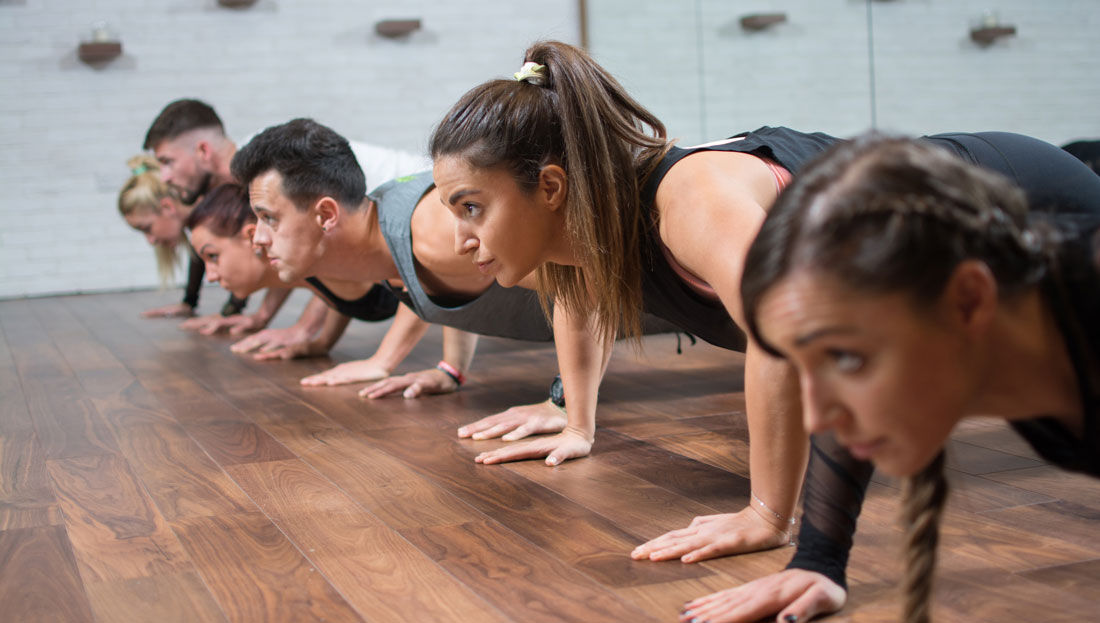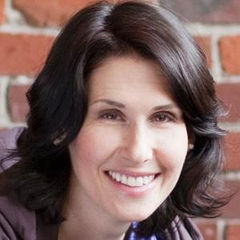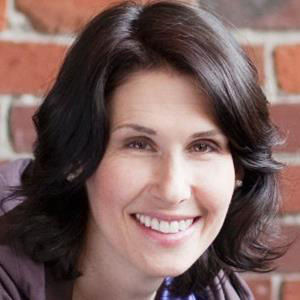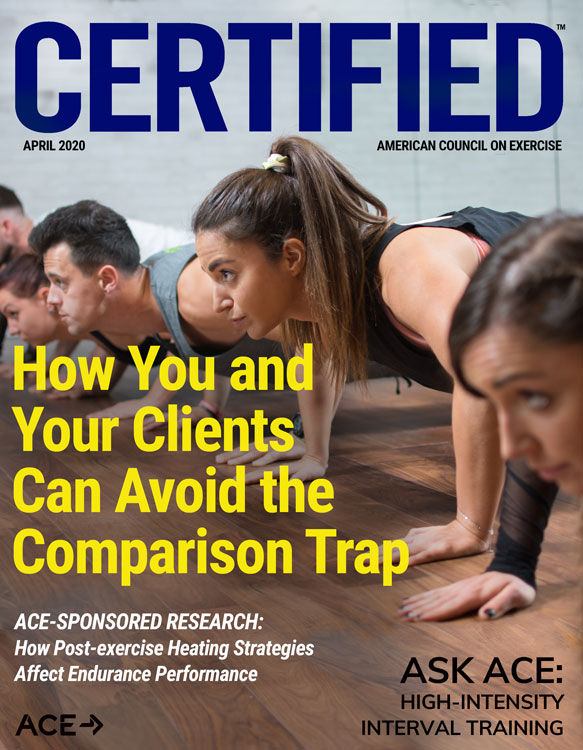
The fitness industry has always been prone to comparisons: We often can’t help evaluating how one person’s body looks next to another’s in fitness classes, at gyms and in advertisements. Or, how one exerciser performs an activity compared to another. Many individuals who work in the industry do it, consciously or not, and our clients definitely do it.
It doesn’t take much to fall into the comparison trap. Almost every fitness studio has mirrors that reflect similarities and differences in body image. Plenty of tech-based classes conspicuously display each participant’s performance metrics for all to see. And then there’s social media, providing endless fodder for daily comparisons and judgments.
This article confronts the comparison trap head on while providing strategies for untangling yourself and your clients from any unhealthy and/or unnecessary perceptions about how we fare among our peers and mentors.
What’s Wrong With Comparing?
When it comes to physical activity, there will always be some people who outperform others—it’s only natural. And so, in many ways, couldn’t comparing oneself to an instructor, trainer or fit gym member help bolster exercise motivation? When there’s someone you want to emulate, in physicality or performance, comparing might make you more inclined to work out harder and/or more often.
“In fitness classes, a beginner might compare him- or herself to a seasoned veteran of that class—I think this is inevitable while working out in a room together,” says Michelle Roots, owner and head coach at Core Conditioning Fitness Studio in Surrey, British Columbia. “As long as it's coming from a place of personal growth, [being motivated by] or looking up to someone can’t hurt.”
Trouble is, comparisons can spill over into negative emotions and poor self-perception. “If we look to others and are inspired to make positive change, comparison can be helpful,” says Gillian Goerzen, a Body Positive Health and Fitness Coach and owner of Super You Studio in Nanaimo, British Columbia. “However, for the majority of people, fitness consumers and professionals alike, comparison leads to self-criticism. And self-criticism is counterproductive to healthy self-efficacy (i.e., belief in your ability to be successful), which is counterproductive to motivation and, ultimately, success!”
In psychology, social comparison theory states that people evaluate their own abilities and attitudes relative to other people in a way that plays a significant role in self-image and subjective well-being. Further, upward social comparison is related to comparing yourself to someone judged to be better than you in some way (e.g., material status or physical fitness).
Considering the latter definition, one of the most obvious targets for upward social comparison is probably the health and exercise professional: instructors teach on stage as “examples” of fitness and personal trainers are predictable role models of fit bodies and good health. It makes sense that clients compare. Fortunately, health and exercise professionals are in a strong position to encourage healthy emulation.
“One of the most important things we can do as professionals is to help our clients see that we’re not perfect, that we don’t have it all figured out, and that our own routines and habits are also constantly evolving and so are our bodies,” says Goerzen, author of The Elephant in the Gym: Your Body Positive Guide to Writing Your Own Health and Fitness Story.
“I try to use myself as motivation for my clients telling them how sometimes I, too, don't want to work out,” says Roots, “but [I share] things I do to motivate myself to get to the gym.”
Shirley Archer, an author, trainer and ACE Group Fitness Instructor based in Los Angeles and Zurich, Switzerland, talks about shifting the focus back to the client and his or her own accomplishments when comparing becomes unproductive. “Reinforce how great whatever it is that the client has been doing consistently to achieve results,” she says.
In any situation, studio owner Carrie Myers advises examining comparisons according to how they serve the client and his or her progress. (You can adopt this same approach for yourself, as well.) “I try not to classify things as ‘good’ or ‘bad,’ but rather ‘healthy’ versus ‘unhealthy,’” says Myers, who owns CarrieMichele Coaching in Lisbon, N.H.
While it’s certainly possible to compare in a healthy way, the potential for a deleterious effect shouldn’t be ignored. For example, Myers is open about having to leave the fitness industry for a while to heal from an eating disorder. “I compared myself to other exercise professionals, including the ones in industry trade publications,” she says. “I simply couldn't get over feeling like I wasn’t measuring up to the images, especially after I had my first baby.”
Drawing comparisons seems to be woven into the fabric of how the fitness industry operates in many ways: There’s no shortage of workout challenges and contests, before/after imagery, publicly shared performance data and more. Should we be doing more to scale back on promoting comparisons, even if they are well intentioned?
How the Industry Breeds Comparisons
In the fitness environment, there’s an obvious continuum of body weights and shapes, muscularity, function, performance and more. Naturally, a lot of people are concerned with where they fall on the continuum, and you might say the fitness industry exploits this tendency. “The industry is full of activities that establish and reinforce comparison,” says Goerzen. “Challenges or competitions where the participants are pitted against one another, especially weight-loss and performance-outcome challenges, are particularly troubling to me.”
According to Goerzen, fitness-driven comparisons may create unrealistic perceptions and expectations among clients. “In many cases, the challenges themselves don’t take into account individual differences,” she says. “And even if they do, the consumer doesn’t fully understand these nuances.”
A lack of understanding about the nuances of health and fitness is perhaps most problematic on social media (prominently, Instagram), where many “fit body” stereotypes have become caricatures and exercise demonstrations appear increasingly more fantastical.
Roots is concerned that aspects of the fitness industry have moved away from promoting overall healthy living “to ‘liking’ images of the leanest bodies and those with the most followers online (who might not be promoting the healthiest form of fitness/active living).” This, says Roots, breeds comparisons “as it seems people are striving to get the best body or be able to perform the craziest exercise in order to gain more followers, likes and attraction.”
How we show up on social media matters a lot. Not surprisingly, studies suggest that comparing oneself to others on social media is not only a thing, it may also trigger feelings of low self-esteem and/or dissatisfaction about appearance and body image (Fardouly and Vartanian 2016; Lewallan and Behm-Morawitz 2016; Vogel et al., 2014; Smith, Hames and Joiner 2013). So far, social media’s vanity metrics such as likes and comments have largely overshadowed more meaningful connections that could genuinely attract people to an active lifestyle.
“The choice of images in fitness industry publications, on websites, in social media, etc., tend to breed comparison,” says Myers, author of Squeezing Your Size 14 Self into a Size 6 World. “And when we use phrases like ‘shrink your waist’ or ‘you can get a body like this’ with accompanying images of very fit models, how can we not compare ourselves to that?”
With that said, Myers adds, “I recognize that ultimately it’s our choice to compare ourselves to others, but it’s also our responsibility as health and exercise professionals to steer our clients in a different direction.” Such a redirection should include additional emphasis on personalization and support, both in the narratives we create on social media and in real-life teachings. “As health and exercise professionals,” says Roots, “we should all help each other grow, not compete against each other.”
Compare Versus Compete
Considering the fitness industry’s connection to sport and performance, it only makes sense that we’ve adopted competitive elements that include comparisons. For example, the point of fitness-related competitions are for one person or team to outperform another, thereby gaining a win or status over others in comparison. There’s nothing inherently bad about this, but even friendly competition can affect clients in different ways. “One person’s comparison is another person’s competition or inspiration,” says Archer. “For some, competition is motivating; for others, it’s demoralizing.”
The difference might lie in how various clients perceive both themselves and their goals. “Competition can be as destructive as comparison if someone is prone to negative comparison,” says Goerzen. In her mind, placing a person with poor self-esteem and high self-criticism in a competitive environment reinforces negative thought patterns. “However,” she says, “if you take someone with healthy self-esteem, self-efficacy and a good toolkit for managing self-criticism (self-compassion, positive self-talk, etc.), and competition is a source of inspiration, then it may be fine.”
Given that competitions and activity challenges are staples of the fitness industry, it’s good to know what type of clients you’re dealing with. Trainers might rely on personalized assessments as one measure. However, you can’t always determine what motivates a diverse group in a class setting. For that reason, holding any type of comparison/competition in a class requires the ability to “read” the room for people who appear reluctant or uncomfortable. From there, the instructor’s coaching, language and attentiveness might help quell potentially unhealthy comparisons while still providing more competitive clients with the motivation they need.
For another approach, check out the sidebar “Holding a Low-comparison Fitness Challenge” for an example of how to motivate clients with a challenge that could appeal to a range of participants.
Quelling Unhealthy Comparisons
When comparing becomes unproductive or discouraging for clients, health and exercise professionals “can make a powerful difference by what they model and what they say,” says Archer. “I can always see progress in my clients and I remind them about it.”
“It’s important to teach our clients to strive to become the best version of themselves, not strive to be like someone else,” says Roots. “I coach clients to set personal goals that are realistic to them and will make them feel good when they reach them.”
The last thing health and exercise professionals want is to unwittingly discourage clients from exercise. To that end, be aware of seemingly innocuous tactics that could exacerbate unhealthy comparisons: “Never tell a client that they can have abs (or whatever) like so-and-so if they just do XYZ,” says Myers. “Avoid encouraging them to find a photo of someone they admire and hang it up for motivation."
“We need to encourage our clients to keep their eyes on their own lane,” says Goerzen, and avoid comparing current body image to past body image, such as “get your pre-baby body back.” Go for instructional and motivational cues that inspire clients and participants to feel gratitude and appreciation for their bodies in a way that doesn’t conjure up comparisons. For example, Myers inspires clients to value how their bodies function in everyday life. “Encourage them to appreciate their bodies for what they can do, as opposed to what they look like,” says Myers.
Finally, infuse your training sessions and classes with real talk about what clients can do to advocate for their own fitness outcomes, irrespective of anyone else’s and/or their own past achievements. “Educate about how training results are affected by genetics, age, nutrition, sleep, hydration, effective rest and restoration—all the factors that shift the power back to each person and to personal choices,” says Archer. And a little levity doesn’t hurt either: “Make jokes about how if we wanted to have such-and-so’s body, we need to have such-and-so’s parents,” says Archer.
Individual Paths to Fitness
It doesn’t take much to adopt a training or teaching style that diverts clients away from unproductively associating their progress/body image/performance with others around them or on social media. “I often tell clients that health and fitness is a science, but the application of it in their lives is an art!” says Goerzen. And there lies the incomparable beauty of a healthy, fit lifestyle: It’s different for everyone.
Holding a Low-comparison Fitness Challenge
Studio owner Michelle Roots recently provided her members with an inspiring fitness challenge that was high on motivation and low on comparisons. Here’s how she did it.
The eight-week challenge was designed to steer clients away from public evaluations, such as winning a prize for the most weight lost or most classes attended, etc. Instead, Roots asked each participating client to email her privately with a personal goal. The goal revolved around how many classes the clients aimed to attend each week for the eight weeks in addition to any other personal goals (e.g., weight loss, strength gains, inches lost, nutrition choices).
“This turned out to be a very successful challenge,” says Roots. “The clients were not comparing themselves to others, yet they were being held accountable to their own personal goals for the eight weeks.” At the end of the challenge, Roots entered anyone who stuck to his or her goal(s) into a drawing for a prize. This is how the “winner” of the challenge was selected.
References
Fardouly, J. and Vartanian, L.R. (2016). Social media and body image concerns: Current research and future directions. Current Opinion in Psychology, 9, 1−5.
Lewallen, J. and Behm-Morawitz, E. (2016). Pinterest or Thinterest?: Social comparison and body image on social media. Social Media + Society, 2, 1.
Smith, A.R., Hames, J.L. and Joiner Jr., T.E. (2013). Status update: Maladaptive Facebook usage predicts increases in body dissatisfaction and bulimic symptoms. Journal of Affective Disorders, 149, 235−240.
Vogel, E.A. et al. (2014). Social comparison, social media and self-esteem. Psychology of Popular Media Culture, 3, 4, 206−222.





 by
by 


